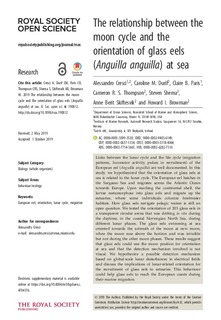| dc.contributor.author | Cresci, Alessandro | |
| dc.contributor.author | Durif, Caroline | |
| dc.contributor.author | Paris, Claire B. | |
| dc.contributor.author | Thompson, Cameron | |
| dc.contributor.author | Shema, Steven | |
| dc.contributor.author | Skiftesvik, Anne Berit | |
| dc.contributor.author | Browman, Howard | |
| dc.date.accessioned | 2020-02-06T10:42:27Z | |
| dc.date.available | 2020-02-06T10:42:27Z | |
| dc.date.created | 2019-12-08T16:39:57Z | |
| dc.date.issued | 2019 | |
| dc.identifier.issn | 2054-5703 | |
| dc.identifier.uri | http://hdl.handle.net/11250/2639989 | |
| dc.description.abstract | Links between the lunar cycle and the life cycle (migration patterns, locomotor activity, pulses in recruitment) of the European eel (Anguilla anguilla) are well documented. In this study, we hypothesized that the orientation of glass eels at sea is related to the lunar cycle. The European eel hatches in the Sargasso Sea and migrates across the Atlantic Ocean towards Europe. Upon reaching the continental shelf, the larvae metamorphose into glass eels and migrate up the estuaries, where some individuals colonize freshwater habitats. How glass eels navigate pelagic waters is still an open question. We tested the orientation of 203 glass eels in a transparent circular arena that was drifting in situ during the daytime, in the coastal Norwegian North Sea, during different lunar phases. The glass eels swimming at sea oriented towards the azimuth of the moon at new moon, when the moon rose above the horizon and was invisible but not during the other moon phases. These results suggest that glass eels could use the moon position for orientation at sea and that the detection mechanism involved is not visual. We hypothesize a possible detection mechanism based on global-scale lunar disturbances in electrical fields and discuss the implications of lunar-related orientation for the recruitment of glass eels to estuaries. This behaviour could help glass eels to reach the European coasts during their marine migration. | nb_NO |
| dc.language.iso | eng | nb_NO |
| dc.title | The relationship between the moon cycle and the orientation of glass eels (Anguilla anguilla) at sea | nb_NO |
| dc.type | Journal article | nb_NO |
| dc.type | Peer reviewed | nb_NO |
| dc.description.version | publishedVersion | nb_NO |
| dc.source.volume | 6 | nb_NO |
| dc.source.journal | Royal Society Open Science | nb_NO |
| dc.source.issue | 10 | nb_NO |
| dc.identifier.doi | 10.1098/rsos.190812 | |
| dc.identifier.cristin | 1757931 | |
| dc.relation.project | Havforskningsinstituttet: 81529 | nb_NO |
| dc.relation.project | Norges forskningsråd: 234338 | nb_NO |
| cristin.unitcode | 7431,0,0,0 | |
| cristin.unitcode | 7431,19,0,0 | |
| cristin.unitcode | 7431,17,0,0 | |
| cristin.unitname | Havforskningsinstituttet | |
| cristin.unitname | Marin økosystemakustikk | |
| cristin.unitname | Sykdom og smittespredning | |
| cristin.ispublished | true | |
| cristin.fulltext | original | |
| cristin.qualitycode | 1 | |
